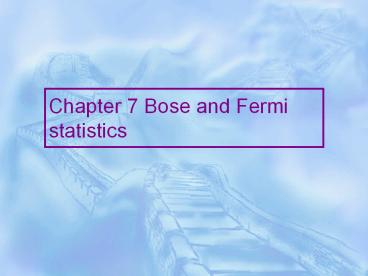Chapter 7 Bose and Fermi - PowerPoint PPT Presentation
1 / 71
Title:
Chapter 7 Bose and Fermi
Description:
Chapter 7 Bose and Fermi statistics We can also use another method: If we integrate the term in the equation above by parts, it follows that: Exercise: 8.3 Request ... – PowerPoint PPT presentation
Number of Views:174
Avg rating:3.0/5.0
Title: Chapter 7 Bose and Fermi
1
Chapter 7 Bose and Fermi statistics
2
7-1 The statistical expressions of thermodynamic
quantities
1?Bose systems
Define a macrocanonical partition function
3
(No Transcript)
4
(No Transcript)
5
Now, lets see the entropy and Lagrange
Variable factor
6
Because
7
(No Transcript)
8
(No Transcript)
9
So that,
10
Boltzmann relation
11
2?Fermi system
(Bose)
12
(No Transcript)
13
Boltzmann relation
14
Addition
Define a new thermodynamic quantity grand
potential
It is of great importance for the statistical
treatment of thermodynamic problems.The total
differential reads
The remaining thermodynamic quantities can be
calculated by differentiating the grand potential
15
Because of Eulers equation
The grand potential is identical with -pV
16
Because
17
7-2 Bose and Fermi weak degeneracy ideal gas
non-degeneracy condition
Now, we consider a condition, just as and
is small ,but can not be neglected. We
called this weak degeneracy condition.
Under this condition, we want to deal with the
Bose ideal gas and Fermi ideal gas respectively.
18
Here g is the degeneracy caused by the particles
spin.
Photon g2
Electron g2
19
Bose
Fermi
This equation can be used to determine the
Lagrange factor .
20
(No Transcript)
21
So that, we expand the
into
22
(No Transcript)
23
(No Transcript)
24
In the equation, the first term is the energy
calculated according to the Boltzmann
distribution, and the second term is the
correlation energy caused by the quantum
statistics.
25
(No Transcript)
26
0
27
(No Transcript)
28
(No Transcript)
29
(No Transcript)
30
(No Transcript)
31
(No Transcript)
32
7-3 Bose-Einstein conglomeration
From this section, we can see that when
equals or is more than 2.612, the unique
Bose-Einstein conglomeration phenomenon will
appear.
Because the can not be negative, So
that
33
That is ,here is the lowest
energy level of Bose particles.
If we assume the lowest energy of the Bose
particle is 0, then,
From the equation
We can see that, the chemical potential is
the function of temperature T and the density
of particle number n .
34
If we substitute integration for the summation,
there is
V
35
If the n is fixed, according to the equation
above, we can see that the higher temperature,
the smaller chemical potential. When the
temperature reduces to a critical value Tc ,the
chemical potential will reach its highest value 0.
Because
36
(No Transcript)
37
Then, if the temperature keep on reduces from Tc,
what will happened?
But, when
38
lt
There is a contradiction in it, because
39
Here n0(T) is the density of particle number on
the energy level , when
temperature is T( ), .
40
(No Transcript)
41
When ,Bose particles will
accumulate on the energy level
rapidly, and the density of particle
number reach the same order of
magnitude with the total particle number density
n .This phenomenon is just the Bose-Einstein
conglomeration.
42
Tc is called conglomeration temperature, on the
energy level of ,we can see
that the momentums of Bose particles are also 0,
so, Bose-Einstein conglomeration is also called
momentum conglomeration.
43
(No Transcript)
44
(No Transcript)
45
7-4 Photon gas
T N(t) const.
According to the idea of particles, we can regard
the photon field in the cavity as a photon gas.
46
Bose statistics
47
Here,
Because the spin degeneracy of photon is 2 (1.-1),
48
Substitute for the equation
49
The equation above is called Plancks formulation.
50
Integrating the equation above, we can obtain the
total energy of the cavity.
51
We can also use another solution
52
(No Transcript)
53
It is the same with what we have obtained before.
54
(No Transcript)
55
7-5 The free-electron gas in the metal
A further, very useful model system is that of a
noninteracting non relativistic gas of Fermi
particles. Nucleons in atoms, as well as
electrons in metals, can be regard as an ideal
Fermi gas to first approcimation. The case T
0 has here a special importance.
It stands for the mean particle number on the
each quantum state.
56
V
However, since the particle possess 2s1
different spin orientations which are
energetically degenerate in the interaction free
case, Equation above must be multiplied by an
additional degeneracy factor g2
We want to rewrite the sums in terms of
integrals.
57
We can also see that the is the function of T
and n.
When T0K
Pauli principle requires an energetically higher
state for each new particle, and the is the
highest energy level of electrons.
58
Is called Fermi energy level.
Is called Fermi momentum, which is the largest
momentum.
59
For example Cu (cuprum)
300K
60
Tgt0
61
(No Transcript)
62
In the first term
63
Because the integration comes from
,especially when the z is small. So, we can
expand the numerator into power series.
64
(No Transcript)
65
(No Transcript)
66
We can also use another method
67
If we integrate the term in the equation
above by parts, it follows that
68
(No Transcript)
69
(No Transcript)
70
(No Transcript)
71
Exercise
8.3 Request the entropy and pressure of weak
degeneracy Bose ideal gas and Fermi ideal gas.































